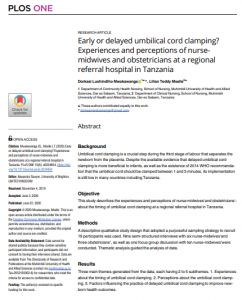
Background
Umbilical cord clamping is a crucial step during the third stage of labour that separates the newborn from the placenta. Despite the available evidence that delayed umbilical cord clamping is more beneficial to infants, as well as the existence of 2014 WHO recommendation that the umbilical cord should be clamped between 1 and 3 minutes, its implementation is still low in many countries including Tanzania.
Objective
This study describes the experiences and perceptions of nurse-midwives`and obstetricians`about the timing of umbilical cord clamping at a regional referral hospital in Tanzania.
Methods
A descriptive qualitative study design that adopted a purposeful sampling strategy to recruit 19 participants was used. Nine semi-structured interviews with six nurse-midwives`and three obstetricians`, as well as one focus group discussion with ten nurse-midwives`were conducted. Thematic analysis guided the analysis of data.
Results
Three main themes generated from the data, each having 2 to 5 subthemes. 1. Experiences about the timing of umbilical cord clamping. 2. Perceptions about the umbilical cord clamping. 3. Factors influencing the practice of delayed umbilical cord clamping to improve newborn health outcomes.